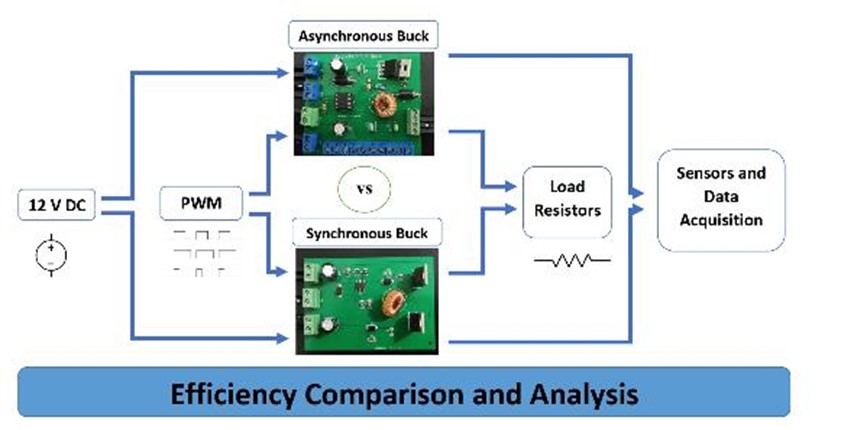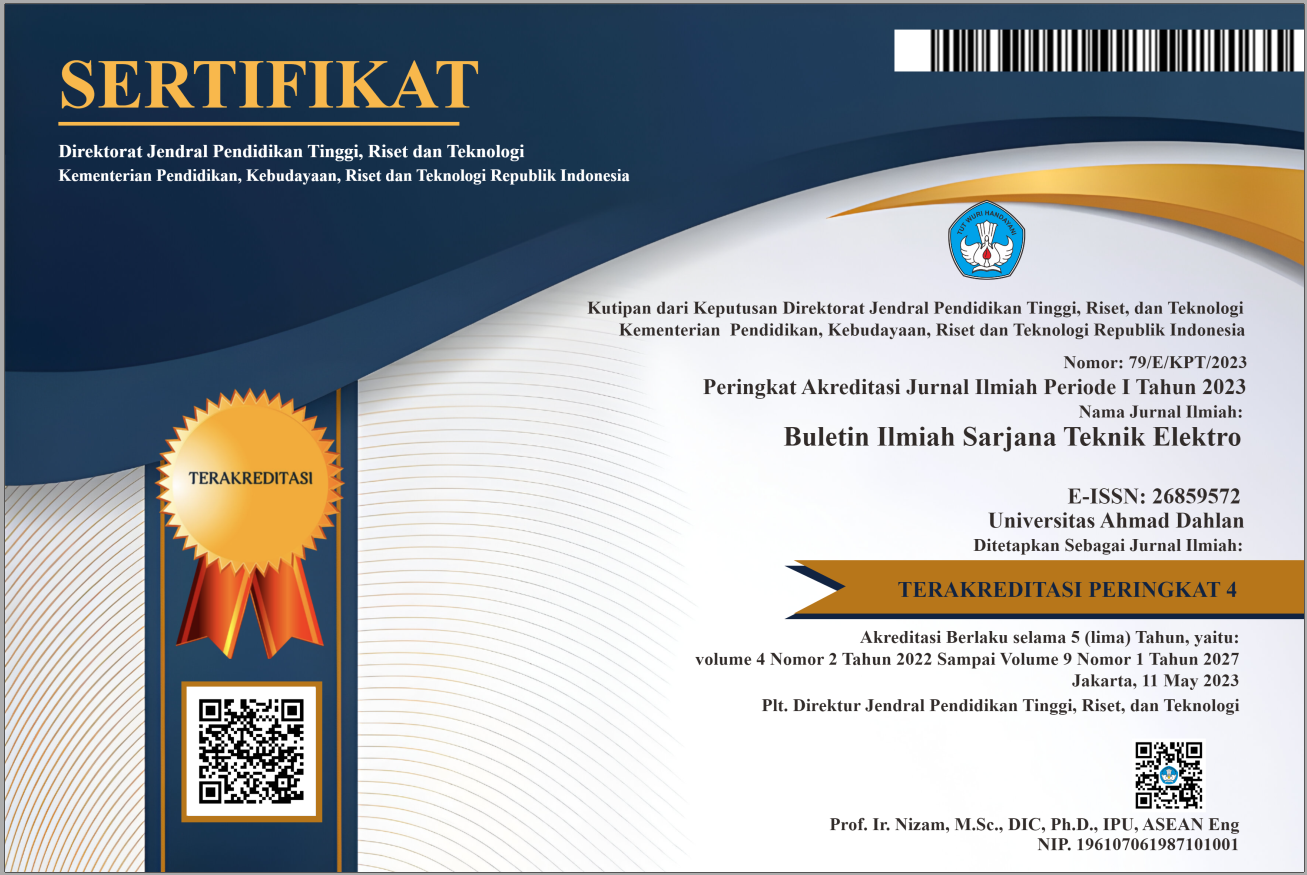Efficiency Comparison of Asynchronous and Synchronous Buck Converter with Variation in Duty Cycle and Output Current
DOI:
https://doi.org/10.12928/biste.v5i1.7386Keywords:
Synchronous, Asynchronous, Buck Converter, EfficiencyAbstract
There are two most commonly used topologies in buck converter applications, asynchronous and synchronous buck converter. These two topologies have its own advantages and disadvantages from a performance point of view. The difference in performance, especially in the aspect of efficiency need to be addressed further, knowing the efficiency is a crucial aspect of buck converter application. In this study, the comparison of asynchronous and synchronous topology in terms of its efficiency will be analyzed using software simulation and hardware prototypes. Software simulation will be used to validate the workings of buck converter prototypes by comparing its characteristics against the hardware prototypes. Furthermore, the performance between both topologies will be analyzed under various operating conditions. Based on the results obtained in this study, when the applied duty cycle is low, for instance in 30% duty cycle and both converters operate at the lowest current, the asynchronous topology have a better efficiency of 19.15% against the synchronous topology, however, when both converters operate at the highest current, the synchronous topology shows its efficiency advantage of 6.56% against the asynchronous topology. On the other hand, in a higher duty cycle operation, for example in 80% duty cycle, both converters have an insignificant difference of efficiency.
References
F. Kurniawan, Lasmadi, O. Dinaryanto, B. Sudibya, and M. R. E. Nasution, “A Novel Boost-Buck Converter Architecture for Improving Transient Response and Output-Voltage Ripple,” J. ICT Res. Appl., vol. 14, no. 2, pp. 149–164, 2020, https://doi.org/10.5614/itbj.ict.res.appl.2020.14.2.4.
S. S. Park, J. S. Lee, and S. D. Yu, “A novel adaptive hysteresis DC-DC buck converter for portable devices,” Turkish Journal of Electrical Engineering and Computer Sciences, vol. 27, no. 2, pp. 807-818, 2019, https://doi.org/10.3906/elk-1809-45.
A. Sheikholeslami, “Buck and Boost Converters [Circuit Intuitions],” IEEE Solid-State Circuits Mag., vol. 13, no. 4, pp. 12–14, 2021, https://doi.org/10.1109/MSSC.2021.3110306.
S. N. Soheli, G. Sarowar, M. A. Hoque, and M. S. Hasan, “Design and Analysis of a DC -DC Buck Boost Converter to Achieve High Efficiency and Low Voltage Gain by using Buck Boost Topology into Buck Topology,” 2018 International Conference on Advancement in Electrical and Electronic Engineering (ICAEEE), pp. 1-4, 2018, https://doi.org/10.1109/ICAEEE.2018.8643001.
K. Chomsuwan, P. Prisuwanna, and V. Monyakul, “Photovoltaic grid-connected inverter using two-switch buck-boost converter,” Conference Record of the Twenty-Ninth IEEE Photovoltaic Specialists Conference, pp. 1527-1530, 2002, https://doi.org/10.1109/PVSC.2002.1190902.
T. A. C. M. Claasen, “An industry perspective on current and future state of the art in system-on-chip (SoC) technology,” in Proceedings of the IEEE, vol. 94, no. 6, pp. 1121–1137, 2006, https://doi.org/10.1109/JPROC.2006.873616.
K. Yao, Y. Meng, and F. C. Lee, “A novel winding coupled-buck converter for high-frequency, high step-down DC/DC conversion,” in PESC Record - IEEE Annual Power Electronics Specialists Conference, vol. 2, pp. 651–656, 2002, https://doi.org/10.1109/PSEC.2002.1022527.
H. H. Chou, W. H. Luo, H. L. Chen, and S. F. Wang, “A Novel Buck Converter with Dual Loops Control Mechanism,” Electron, vol. 11, no. 8, p. 1256, 2022, https://doi.org/10.3390/electronics11081256.
H. Sucu, T. Göktaş, and M. Arkan, “Design, Simulation and Application of Buck Converter with Digital PI Controller,” Balkan Journal of Electrical and Computer Engineering, vol. 9, no. 2, pp. 106–113, 2021, https://doi.org/10.17694/bajece.884290.
P. Barrade, “Switched-mode converters (one quadrant),” in CAS - CERN Accelerator School and CLRC Daresbury Laboratory : Specialised CAS Course on Power Converters, pp. 185–208, 2006, http://dx.doi.org/10.5170/CERN-2006-010.185.
I. Batarseh and A. Harb, Power Electronics, 2nd ed. Cham: Springer, 2018, https://doi.org/10.1007/978-3-319-68366-9.
P. Rajeswari and V. Manikandan, “Analysis of effects of MOSFET parasitic capacitance on non-synchronous buck converter electromagnetic emission,” Ain Shams Engineering Journal, p. 102041, 2022, https://doi.org/10.1016/j.asej.2022.102041.
J. Pathan, “Model Predictive Control of DC-DC Buck Converter and Its Comparison With Pid Controller,” International Journal of Advanced Research in Engineering and Technology, vol. 11, no. 9, 362-367, 2020, https://ssrn.com/abstract=3713708.
I. Sudiharto, M. I. Rahadyan, and O. A. Qudsi, “Design and Implementation of Buck Converter for Fast Charging with Fuzzy Logic,” JAREE (Journal on Advanced Research in Electrical Engineering), vol. 5, no. 1, 2021, https://doi.org/10.12962/jaree.v5i1.146.
M. Rashid, Power electronics: circuits, devices, and applications, 3rd ed. New Jersey: Pearson, 2003.
B. Bryant and M. K. Kazimierczuk, “Modeling the closed-current loop of PWM boost DC-DC converters operating in CCM with peak current-mode control,” in IEEE Transactions on Circuits and Systems I: Regular Papers, vol. 52, no. 11, pp. 2404-2412, 2005, https://doi.org/10.1109/TCSI.2005.853904.
G. Dileep and S. N. Singh, “Selection of non-isolated DC-DC converters for solar photovoltaic system,” Renewable and Sustainable Energy Reviews, vol. 76, pp. 1230–1247, 2017, https://doi.org/10.1016/j.rser.2017.03.130.
A. S. Kislovski, R. Redl, and N. O. Sokal. Dynamic analysis of switching-mode DC/DC converters. Springer Science & Business Media, 2012, https://doi.org/10.1007/978-94-011-7849-5.
R. Abhishek, P. Zoting, and P. Ragit, “Design and Analysis of a DC -DC Buck converter and Boost Converter to Achieve High Efficiency by altering duty cycle and input voltage,” International Journal of Scientific and Research Publications, vol. 10, no. 6, pp. 731–738, 2020, https://doi.org/10.29322/IJSRP.10.06.2020.p10285.
N. B. M. Posdzi, N. B. Mahmor, and R. B. A. Rani, “Design buck converter with variable switching frequency by using matlab simulink simulation,” International Journal of Technology, Innovation, and Humanities, vol. 1, no. 1, pp. 1–6, 2020, https://doi.org/10.29210/881201.
S. Trakuldit, K. Tattiwong, and C. Bunlaksananusorn, “Design and evaluation of a Quadratic Buck Converter,” Energy Reports, vol. 8, pp. 536–543, 2022, https://doi.org/10.1016/j.egyr.2021.11.124.
O. Djekic and M. Brkovic, “Synchronous rectifiers vs. Schottky diodes in a buck topology for low voltage applications,” PESC Rec. - IEEE Annu. Power Electron. Spec. Conf., vol. 2, pp. 1374–1380, 1997, https://doi.org/10.1109/PESC.1997.616947.
I. K. Murad, “Efficiency of Synchronous and Asynchronous Buck-Converter at Low Output Current,” Journal of University of Babylon for Engineering Sciences, vol. 27, no. 2, pp. 194–206, 2019, https://doi.org/10.29196/jubes.v27i2.2337.
O. Djekic, M. Brkovic, and A. Roy, “High frequency synchronous buck converter for low voltage applications,” PESC Rec. - IEEE Annu. Power Electron. Spec. Conf., vol. 2, pp. 1248–1254, 1998, https://doi.org/10.1109/PESC.1998.703166.
M. Jing-Ran, Q. Yao-Jun, S. Yan-Xia, K. Shunshoku, and B. Jing, “Design of Semiconductor Synchronous Buck Converter based on GaNWide-bandgap,” Journal of Physics: Conference Series, vol. 1486, no. 7, p. 072022, 2020, https://doi.org/10.1088/1742-6596/1486/7/072022.
I. N. W. Satiawan, I. B. F. Citarsa, and I. M. B. Suksmadana, “Design and Control a High Gain Synchronous Buck Converter for a Solid State Distribution Transformer,” Journal of Physics: Conference Series, vol. 1569, no. 3, 2020, https://doi.org/10.1088/1742-6596/1569/3/032090.
H. Eraydin and A. F. Bakan, “Efficiency Comparison of Asynchronous and Synchronous Buck Converter,” Proc. - 2020 6th Int. Conf. Electr. Power Energy Convers. Syst. EPECS 2020, pp. 30–33, 2020, https://doi.org/10.1109/EPECS48981.2020.9304966.
H. Zomorodi and E. Nazari, “Design and Simulation of Synchronous Buck Converter in Comparison with Regular Buck Converter,” International Journal of Robotics and Control Systems, vol. 2, no. 1, pp. 79–86, 2022, https://doi.org/10.31763/ijrcs.v2i1.538.
N. R. Jalakanuru, “Comparative Analysis of Buck, Synchronous Buck and Modified Synchronous Buck Converters for Portable Applications,” International Journal of Science Technology & Engineering, vol. 2, no. 5, pp. 106–111, 2015, https://ijste.org/Article.php?manuscript=IJSTEV2I5042.
F. Badr, “The Effect Of Resistive Load Variations On The Open-Loop Control Of Dc-Dc Buck Converter,” Journal of Engineering and Sustainable Development, vol. 17, no. 6, pp. 87–96, 2013, https://jeasd.uomustansiriyah.edu.iq/index.php/jeasd/article/view/1027.
A. W. N. Husna, S. F. Siraj and M. H. Mat, “Effect of Load Variations in DC-DC Converter,” 2011 Third International Conference on Computational Intelligence, Modelling & Simulation, pp. 394-398, 2011, https://doi.org/10.1109/CIMSim.2011.78.
S. Masri, N. Mohamad, and M. H. M. Hariri, “Design and development of DC-DC buck converter for photovoltaic application,” 2012 International Conference on Power Engineering and Renewable Energy (ICPERE), pp. 1-5, 2012, https://doi.org/10.1109/ICPERE.2012.6287236.
D. W. Gao, Energy storage for sustainable microgrid, Elsevier Inc., 2015, https://books.google.co.id/books?hl=id&lr=&id=VWEpBgAAQBAJ&oi=fnd&.
C. Deekshitha and K. L. Shenoy, “Design and simulation of synchronous buck converter for LED application,” 2017 2nd IEEE International Conference on Recent Trends in Electronics, Information & Communication Technology (RTEICT), pp. 142-146, 2017, https://doi.org/10.1109/RTEICT.2017.8256574.
Z. Iqbal, U. Nasir, M. T. Rasheed, and K. Munir, “A comparative analysis of synchronous buck, isolated buck and buck converter,” 2015 IEEE 15th International Conference on Environment and Electrical Engineering (EEEIC), pp. 992-996, 2015, https://doi.org/10.1109/EEEIC.2015.7165299.
M. Dinesh and K. Sathish, “Design and Control of Buck Converter using PI control and Reference Regulator Technique,” International Journal on Recent Technologies in Mechanical and Electrical Engineering, vol. 2, no. 3, pp. 46–49, 2015, https://www.ijrmee.org/index.php/ijrmee/article/view/174.
A. Castaldo, Switching regulator fundamentals-application report-switching regulator fundamentals. Texas Instruments, Tech. Rep., 2019.
G. C. Diyoke, “Analysis and Simulation Of Buck Switch Mode Dc To Dc Power Regulator,” International Journal of Technical Research & Applications, vol. 3, no. 1, pp. 97–103, 2015, https://www.ijtra.com/abstract.php?id=analysis-and-simulation-of-buck-switch-mode-dc-to-dc-power-regulator.
N. Murshed, M. S. K. Tushar, and S. Chowdhury, “Power Performance Analysis of PV Module with DC to DC Buck Converter,” Advanced Journal of Graduate Research, vol. 8, no. 1, pp. 27–39, 2020, https://doi.org/10.21467/ajgr.8.1.27-39.
S. Murmu and M. B. Sharma, “Study and Design, Simulation of PWM based Buck converter for Low Power Application,” IOSR Journal of Electrical and Electronics Engineering (IOSR-JEEE), vol. 10, no. 4, pp. 1–17, 2015, https://www.iosrjournals.org/iosr-jeee/pages/10(4)Version-2.html.
R. Khanna, “LM5033,LM5115 Analyzing Power Modules Literature Number: SNVA590,” 2005.
R. Lai, F. Wang, R. Burgos, D. Boroyevich, D. Zhang and P. Ning, “A Shoot-Through Protection Scheme for Converters Built With SiC JFETs,” in IEEE Transactions on Industry Applications, vol. 46, no. 6, pp. 2495-2500, 2010, https://doi.org/10.1109/TIA.2010.2070785.
T. Abuzairi, W. W. A. Ramadhan, and K. Devara, “Solar Charge Controller with Maximum Power Point Tracking for Low-Power Solar Applications,” International Journal of Photoenergy, vol. 2019, 2019, https://doi.org/10.1155/2019/5026464.
A. Rezky, K. Devara, N. S. Wardana, S. Ramadhanty, and T. Abuzairi, “Simple method for I-V characterization curve for low power solar cell using arduino nano,” E3S Web of Conferences, vol. 67, p. 01020, 2018, https://doi.org/10.1051/e3sconf/20186701020.
R. Nowakowski and N. Tang, “Efficiency of synchronous versus nonsynchronous buck converters,” 2009.

Downloads
Published
How to Cite
Issue
Section
License
Copyright (c) 2023 Ralfi Wibowo Rachmad, Tomy Abuzairi

This work is licensed under a Creative Commons Attribution-ShareAlike 4.0 International License.
Authors who publish with this journal agree to the following terms:
- Authors retain copyright and grant the journal right of first publication with the work simultaneously licensed under a Creative Commons Attribution License that allows others to share the work with an acknowledgment of the work's authorship and initial publication in this journal.
- Authors are able to enter into separate, additional contractual arrangements for the non-exclusive distribution of the journal's published version of the work (e.g., post it to an institutional repository or publish it in a book), with an acknowledgment of its initial publication in this journal.
- Authors are permitted and encouraged to post their work online (e.g., in institutional repositories or on their website) prior to and during the submission process, as it can lead to productive exchanges, as well as earlier and greater citation of published work (See The Effect of Open Access).
This journal is licensed under a Creative Commons Attribution-ShareAlike 4.0 International License.


